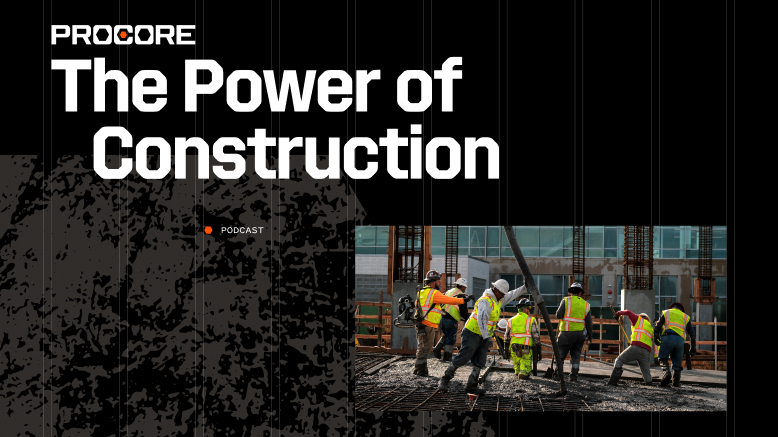— 9 min read
Bid Rigging: Fighting an Unfortunately Common Practice
Last Updated Oct 3, 2025
Scott Bornman
Principal, Operational Excellence
15 articles
Scott Bornman is a managing strategic product consultant at Procore Technologies. Scott began his long construction career after a successful 8+ years in the U.S. Army, where he selected to be U.S. Army Recruiter following Desert Shield/Desert Storm. Scott has had many roles in the construction field since then, working his way from a project superintendent, to an owner's rep, to a senior project manager and even Vice President of Construction at Bognet Construction and Director of Construction at Plaza Construction before joining the team at Procore.
Kacie Goff
Contributing Writer
87 articles
Kacie Goff is a construction writer who grew up in a construction family — her dad owned a concrete company. Over the last decade, she’s blended that experience with her writing expertise to create content for the Construction Progress Coalition, Newsweek, CNET, and others. She founded and runs her own agency, Jot Content, from her home in Ventura, California.
Last Updated Oct 3, 2025

Theoretically, the construction bidding process gives the group funding a project a way to hire work for the best price. Comparing different bids allows them to see how much different companies would charge. This way, the owner can choose the contractor who can provide the type and quality of work they need for the most competitive price.
Unfortunately, though, the construction industry has a widespread issue that compromises the process: bid rigging.
To start, a bid rigging definition: Bid rigging occurs when some or all of the bidders collude to influence who gets awarded the project contract and/or at what price point.
Bid rigging construction projects is against the law. Because stakeholders have so much to manage during the bidding process, though, they often miss the signs. As a result, rigging still takes place in the construction industry today.
Table of contents
Laws Against Bid Rigging
In 1890, a federal statute began prohibiting certain activities that could limit business competition. The Sherman Antitrust Act has wide-ranging implications, and that includes bid rigging construction projects. Specifically, that Act prohibits any agreement between competitors to limit competition and rig bids.
The Department of Justice (DOJ) and other law enforcement agencies can investigate suspected bid rigging. If they discover criminal activity, they can assess a penalty of up to $1 million for individuals, $100 million for companies, or twice the gain or loss from the offense. Additionally, the person charged with bid rigging may face up to ten years in prison.
States often have their own laws to limit anti-competitive activities, too. In Pennsylvania, for example, anti bid-rigging measures are built into the state’s statutes. In addition to federal penalties for bid rigging, parties found guilty may be subject to state penalties.
Types of Bid Rigging
A bid rigging definition can extend to multiple activities that bidders undertake throughout the procurement process to influence who gets awarded the contract. Many of those activities fall into specific rigging categories.
Complementary/Cover Bidding
With this type of bidding, a bidder submits a proposal that they don’t expect to be accepted in an effort to make the desired bidder’s bid look better. The price in the cover bid may be overly high or the bid may not meet some of the term requirements, for example.
Phantom Bidding
This practice informs competitors of a potential bid number in an effort to encourage them to alter their bid. The supposed bid (i.e., the phantom bid) never actually materializes, though.
Bid Suppression
This type of rigging means either not submitting a bid at all or withdrawing one that’s already been submitted in an effort to limit competition for the desired bidder.
Non-Conforming Bidding
With this kind of bid rigging, the bidder intentionally formats their bid so that it doesn’t meet some of the specifications, standards, or other requirements on the project. This means their bid will be disqualified, increasing the odds of the desired bidder being chosen.
Oftentimes, these rigging tactics are used in bid rotation, during which at least two competitors work together.
With bid rotation, the goal is to cycle who wins the contract between each colluding party. So if Contractor A, Contractor B, and Contractor C agree to bid rotations, B and C might submit falsified bids (e.g., ones with overly high numbers) to ensure A gets awarded the contract on this project. Next time, A and C might skew their bids so that B gets the award. On the third project, A and B would modify their bids in an effort to ensure C gets the contract.
In other instances, the competitors won’t decide to rotate but will instead carve out their own market or customer allocation. Say competitors have agreed to give Contractor A certain zip codes in one metropolitan area, for example. If an invitation to bid goes out for a project in that zip code, Contractors B and C may submit complementary bids or no bids at all in an effort to ensure Contractor A gets the project
Cui bono — who benefits from bid rigging?
Because bid rigging construction projects means breaking the law, parties only choose to do it when they expect benefits.
In many cases, bid rigging helps colluding competitors to maintain a steady flow of work. They may believe that bid rotation will enable them to keep their teams employed with more consistency than competitive bidding would.
Plus, bid rigging often allows contractors to pad their margins. In a bid rotation scheme, for example, all of the contractors can inflate their prices knowing that they’ll still beat their “competitors” if it’s their turn to win the contract.
It’s not uncommon for other perks to be layered on, too. If a construction manager (CM) is privy to the bid rigging, they may see an upside. The contractor who gets awarded the contract often owes them a favor, which could take the form of gifts, services rendered, or allowances on future projects. Or they may ask the contractor to submit a sham bid on a future project so they can meet the required number of bids for consideration.
General contractors (GCs) may also loop subcontractors into their bid rigging, offering potential benefits to both parties (at the cost of breaking the law).
If that GC has a relationship with all major electrical contractors in the area, for example, they may be able to guarantee a certain amount of work to them through bid rotation. The GC will likely expect a favor in return, though. They may require the electrical contractor to come in at a certain number, allowing them to build a bigger profit margin for their GC firm.
Ultimately, plenty of people stand to benefit from bid rigging construction projects. This illegal practice hurts one party most: the project owner. As the one funding the project, they’re the ones to suffer when the bidding process isn’t fair. Bid rigging prevents them from being able to find the best work at the best price.
This gets especially problematic on public projects, when the taxpayers’ dollars fund the work.
Warning Signs of Bid Rigging
Because bid rigging is widespread, project owners, project managers, and construction managers should be on the lookout for it. Some indicators of bid rigging construction projects include:
- Identical bids
- Bids that read very similarly except for a few key lines
- Bids that have notable deviation from expected project costs (especially if all of the submitted bids fall into a similar range)
- Bidders that plan to subcontract some or all of the work out to other bidders
- No bid arriving on bid day, despite one being promised upon receipt of the bid package
- Bids from competitors arriving from the same fax number, in envelopes of the same style, or with the same handwriting
- Errors replicated across bids (e.g., the same spelling error in several competitors’ bids)
It also helps to look for patterns. Do the same companies seem to win contracts? Does a GC firm rotate through a list of subcontractors? Could you draw out the “territories” of different contractors on a map based on past work?
Unfortunately, contractors aren’t the only ones engaged in bid rigging behaviors. When another party (e.g., a CM) is involved by leveling the bids and making a recommendation on them, owners and their teams should look for potential signs of rigging. Those include:
- Added lines in bid leveling documents that make bids look artificially high or low
- Recommendations for awarding the contract that aren’t in line with the lowest bidder
- Unexplained fees or line items, especially ones that aren’t readily called out in bid leveling documents
The Department of Justice (DOJ) has a tip sheet that can further help here.
Mitigating Bid Rigging
In addition to watching out for the above warning signs, people involved in the bidding process can take further steps to limit their risk of bid rigging. Those include:
- Using a sealed bidding process
- Increasing the number of bids required (the higher the number, the harder it is for all “competitors” to collude)
- Auditing submitted bids
- Including a non-collusion affidavit that contractors have to sign as part of the bid documents
- Limiting communication between bidders (e.g., scheduling separate bid walks with each bidder individually)
- Training teams that will be reviewing bids on the signs of bid rigging
- Maintaining procurement records from previous projects and comparing bids against them, especially when numbers seem anomalous
- Asking bidders to justify the prices they submitted when they don’t seem in line with market standard
It also behooves project owners, construction managers and their teams to listen to reports of bid rigging. It can be tempting to dismiss contractors who claim they lost a contract because of bid rigging, assuming they’re disgruntled over the loss of business. But contractors who step forward risk getting blackballed, so few will do so without reason.
When it comes to bid rigging mitigation efforts, technology can also be a huge help. Bid leveling software makes it easier to call out discrepancies and identify line items that impact the overall bid but might otherwise get lost in the shuffle.
And as artificial intelligence (AI) advances, this should only get easier. Running an AI-supported check for any anomalies can pinpoint issues human eyes might slide right past.
Reporting Suspected Bid Rigging
If bid rigging is suspected on a project, the DOJ’s Antitrust Division can step in and investigate. To initiate an investigation, a person needs to submit:
- The name of any parties involved (companies and individuals)
- How those parties may have violated federal antitrust laws
- Examples of that violation
- The product or service impacted by the violation
- The major competitors selling that product or service
- An explanation of their role in the situation
- A list of others being affected and the way in which they’re being affected
People can call this information into the DOJ’s antitrust violation Complaint Center at (888) 647-3258. Alternatively, a document hitting all of these points can be submitted to the DOJ via email at antitrust.complaints@usdoj.gov or mail at the following address:
Complaint Center
Antitrust Division
950 Pennsylvania Ave., NW
Room 3337
Washington, DC 20530
Once a complaint is submitted, the Antitrust Division creates a record and assigns it to a staff member for review. Complaints are kept confidential. The DOJ Complaint Center has more information about initiating an investigation into antitrust violations, including bid rigging.
NOV 6, 2025 at 11:00 AM PST / 2:00 PM EST
Free Webinar: Prove your project management software is profitable
Join Procore and Dodge Data & Analytics for a 2025 Dodge ROI Report deep dive.

Was this article helpful?
Thank you for your submission.
100%
0%
You voted that this article was . Was this a mistake? If so, change your vote
Scroll less, learn more about construction.
Subscribe to The Blueprint, Procore’s construction newsletter, to get content from industry experts delivered straight to your inbox.
By clicking this button, you agree to our Privacy Notice and Terms of Service.
Thank you!
You’re signed up to receive The Blueprint newsletter from Procore. You can unsubscribe at any time.
Categories:
Written by
Scott Bornman
Principal, Operational Excellence | Procore Technologies
15 articles
Scott Bornman is a managing strategic product consultant at Procore Technologies. Scott began his long construction career after a successful 8+ years in the U.S. Army, where he selected to be U.S. Army Recruiter following Desert Shield/Desert Storm. Scott has had many roles in the construction field since then, working his way from a project superintendent, to an owner's rep, to a senior project manager and even Vice President of Construction at Bognet Construction and Director of Construction at Plaza Construction before joining the team at Procore.
View profileKacie Goff
Contributing Writer | Procore Technologies
87 articles
Kacie Goff is a construction writer who grew up in a construction family — her dad owned a concrete company. Over the last decade, she’s blended that experience with her writing expertise to create content for the Construction Progress Coalition, Newsweek, CNET, and others. She founded and runs her own agency, Jot Content, from her home in Ventura, California.
View profileExplore more helpful resources

What Happens When Data Drives the Business?
Construction has long been seen as a low-margin industry. But what if the real problem isn’t the margins—it’s how decisions get made? In episode 17 of The Power of Construction,...

Vet Contractors with Confidence: A Guide to Smart Bidder Selection
Selecting the right bidder is one of the most consequential decisions a construction team makes — yet it often happens under tight deadlines, with limited visibility into the long-term implications....

The Construction Bid Interview & Follow-up: Closing the Deal
During construction project bidding, the interview is often the last part of the request for proposal (RFP) process and one of the most influential. For teams that advance to the...
Construction Business Development: Tracking and Winning the Right Opportunities
Construction business development isn’t just a response to deadlines: It’s a long-term strategy rooted in focus, visibility and timing. Delays, funding gaps and market pressure have made it harder to...
Free Tools
Calculators
Use our calculators to estimate the cost of construction materials for your next project.
Templates
Find a template to help you with your construction project tasks.
Material Price Tracker
Get the latest U.S. retail prices and view historical trends for common building materials.
Glossary
Explore key terms and phrases used in the industry.
